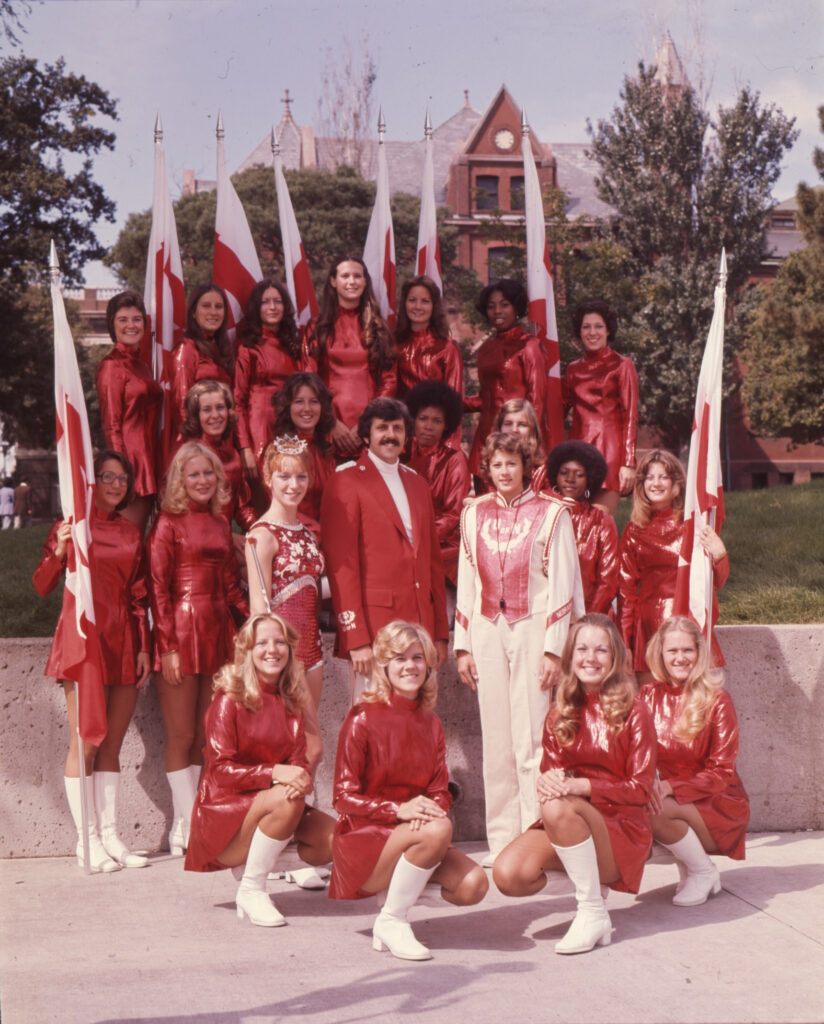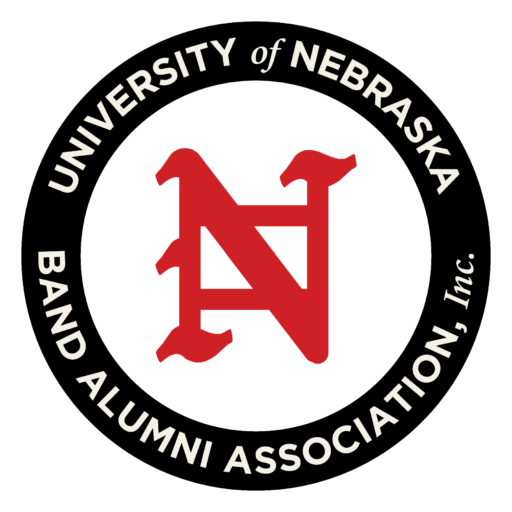Huskerettes
We can’t cover the history of flags in the Cornhusker Marching Band without mentioning the brief history of the Huskerettes in 1961-62. Although the Huskerettes were created to be a high-stepping dance team, much like the Rockettes, they occasionally incorporated large red flags during their halftime performances. The dance team was taught by Mrs. Maly, who previously taught in the physical education department.

1961 members: Karma Anderson, Susan Blevens, Jean Brooks, Liz Brooks, Diane Cabella, Maureen Frazier, Shirley Hoffman, Karen Jo Jackson, Rosella Lange, Judy Leeke, Linda Levenick, Mary Ann Mummel, Tish Pedley, Sharon Rogers, Carolyn Scanlon, Judi Schmoker, Janie Thomason, Lynda Tideswell, Kaye Wagner, Janet Watson, and Wendy Wendt. Mrs. Maly, coach.
After one of their performances in their first year, a zealous law student, Robert Snell, wrote a letter to the Student Council stating that it was not legal. Snell cited Sec 28-1104 and following of the Nebraska Revised Statues of 1943 which prohibits either display or custody of red flags except for railroad and construction workers.
Band director Jack Snider responded by saying the Huskerettes had made the flags from material left over from previous years. “Red was the only material we had and there was no budget allotment to purchase flags,” he said. “The flags would cost about $10-20 each if we purchased them,” Snider said. “We would be glad to receive any contributions the Law College would care to donate.”
The Student Council stated they would investigate the matter further. However, the Huskerttes only lasted one more year and were disbanded in 1962.
The Huskerttes dance team that performed at basketball games from 1979 to 1985 were not a part of the band.
Flag Corps
In the fall of 1975, the band became under the charge of Dr. Robert Fought after Jack Snider stepped away from directing the marching band. “Doc” Fought added a brand-new flag and dance corps comprised of 16 members plus three alternates. Dubbed the “Ladies in Red,” the new group carried red and white banners attached to 8-foot poles with large, pointed tips on the top making them look like spears. The flags were not made of the lightweight silk fabric used today but were more of a canvas. Because of the size and weight of the flags, the corps wore white belts which contained a cup in the front in which the flagpoles were inserted while marching. Routines were minimal and mostly provided color while marching in formations. The same tilt and shake routine established by the first flag line used for marching off the field to “Hail Varsity” is still used today.
Debbie DeFrain was working part-time for UNL Bands in the library and other duties as assigned. Doc asked if Debbie could make practice flags since they were expensive to purchase. Debbie bought one-inch red/white gingham fabric by the bolt to make those flags.
Quentin Bennett, graduate assistant, was put in charge of the flag corps their first year. Bennett played trumpet in the Cornhusker Marching Band from 1970-74. Bennett attended a clinic in Kansas to learn basic flag maneuvers. The clinic was directed by the University of Kansas flag corps director, who had started the KU flag team the year before. He taught the new corps basics during band camp and simple choreography during the season.
To make their debut at the first game of the 1975 season, the flag corps was “hidden” in the middle of the instrumentalists for the march to the stadium. They kept their flagpoles down and the flags unfurled. When the band began to play “Hail Varsity” they flipped up the flags and began to let their flags wave, surprising the watching crowd.
During the school year, the team would practice at 7:15 a.m. before the band came out onto the field at 8:00 a.m. In those days, there wasn’t a “Scarlets” dance squad, so on occasion during quarter breaks the corps performed dance routines on the sidelines.
Of the members, 16 marched at halftime and were selected from week to week based on practice attendance, illness, and general ability. Squad leaders were Noela VanAndel and Suzanne Millet, assistant squad leaders were Reane Hietbrink and Nancy Lawlor.

1975 members:
- Kathy Anderson
- Ann Coen
- Brenda Daugherty
- Sue DeBoer
- Sue Frederick
- Roni Gamble
- Beth Grubauch
- Renae Hietbrink
- Paula Hiller
- Kathi Johnson
- Twyla Lambert
- Libby Lawler
- Nancy Lawler
- Suzanne Millet
- Nila Moore
- Vicki Perry
- Kristi Schlegel
- Noala Van Andel
The next year, Diane Tangeman, featured twirler with the marching band from 1969-74, was asked to help for the 1976 season. By 1977, Joyce (Burns) Thimgan was asked to coach the flag corps. Joyce was the original featured twirler, also known as the Golden Girl, from 1961-64.
“I said, ‘What’s a flag corps?’ He [Jack Snider] says, ‘Oh, it’s just an oversized baton,” Thimgan said.
Thimgan was provided with numerous films of other women carrying 10-foot flags. As the flags were too large to spin, the women just carried them as decoration. It didn’t take long for Thimgan to decide that wasn’t going to work and she got 6-foot PVC pipes instead to allow for better handling and more active choreography.
Eventually, 6-foot fiberglass poles were purchased. The new fiberglass poles left a lot of painful fiberglass slivers in the hands until they were worn down and smoothed after use.
In April of 1986, 23 present and former flag corps members with instructor, Carol Domina, participated in the filming of the miniseries “Amerika.” Filming took place in Tecumseh, Nebraska, as part of a fictional “Lincoln Day” parade. The performers wore uniforms provided by the producers of the miniseries to look like a small-town flag corps. Each member was paid about $10 for appearing in the show. The miniseries aired in 1987 on ABC television.
Flag Line
Over the years, the flag line continued to develop and change with the times. Beginning in the fall of 1987 and into the early 1990s, 5-foot poles were used, often made from fiberglass or aluminum. Because of the conditions of wind in the bowl of Memorial Stadium, tosses were hard to execute because of the light weight of the poles.
In 1988, the name changed from Flag Corps to the Flag Line to reflect the more modern style that was popular in competitive drum corps. The flag silks also evolved to include color and design that reflected the theme of the halftime show. Red and white flags are still used in the pregame performance with the school songs.
Color Guard
Eventually, the flag line returned to 6-foot aluminum poles with weights allowing more intricate choreography, and at last, flag swinging tosses. More recently, rifles have been included into the military themed shows around Veteran’s Day. With the addition of rifles, the name was updated once again to reflect more accurate terminology.
For over 40 years, the UNL Flag line consisted of only female performers; however, in 2013, freshman Sam Guyer became the first male to join the line. He was one of only two men to try out for the line. Guyire’s inclusion made waves but he expressed enthusiasm about the experience and encouraged other men to join the team. The line has been co-ed ever since.
View the color guard throughout the years.
References:
- Go Wave Your Flag—Provided It’s Not Red, The Daily Nebraskan. October 24, 1961, Page 1
- New marching band director plans flag corps, The Daily Nebraskan. March 17, 1975, Page 9
- ‘The Ladies’ chill for halftime shows, The Daily Nebraskan. October 25, 1975, Page 3
- NU flag corps will perform in ‘Amerika’, The Daily Nebraskan. April 4, 1986, Page 1
- Nebraska’s First Male Color Guard Performer, Star City News on YouTube, November 12, 2013
- Meet the unsung women who helped redefine the Cornhusker Marching Band, Lincoln Journal Star, March 16, 2025
